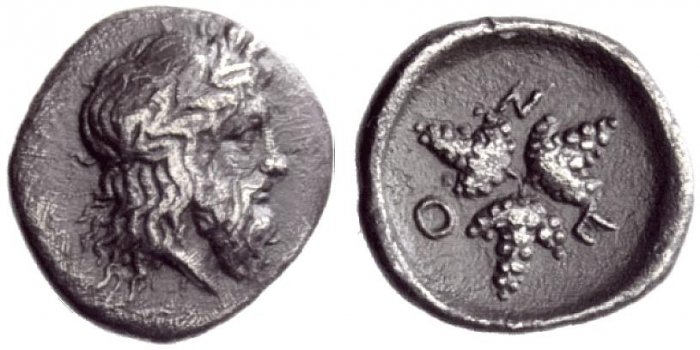S 1869 - Opous (Locrians), silver, tritetartemoria (350 BCE)
From SILVER
350 BCE - 350 BCE Silver 105 kg
Description
| ObverseInscription or printing placed on the obverse.: | Laureate head of Zeus r |
| ReverseInscription or printing placed on the reverse.: | O, Π and N in the spaces between them (Greek).Three bunches of grapes pointing outwards |
Mint and issuing power
| MintIdentifies the place of manufacture or issue of a numismatic object.: | Opous | Ancient regionAncient region.: | Locri Opuntii (Opus) | Modern countryModern country: Greece | AuthorityIdentifies the issuing power. The authority can be "pretended" when the name or the portrait of X is on the coin but he/she was not the issuing power. It can also be "uncertain" when there is no mention of X on the coin but he/she was the issuing power according to the historical sources: |
Chronology
| FromIdentifies the initial date in a range assigned in a numismatic context. | 350 BCE | toIdentifies the final date in a range assigned in a numismatic context.. | 350 BCE | PeriodTime period of the numismatic object.: Classical 480-323 BC |
Physical description
| MetalThe physical material (usually metal) from which an object is made.: | Silver |
Median weightMedian of the weights of numismatic objects (in grams). in grams | 0.60 | DenominationTerm indicating the value of a numismatic object. Examples: tetradrachm, chalkous, denarius.: | tritetartemorion | StandardStandard.: |
Image

S1869 Lokrians tritetartemoria.jpg [1]
References
| Die study referencePublication of the study: | Morineau Humphris - Delbridge 20141Morineau Humphris - Delbridge 2014, p. 159 | ||
| Coin series referenceReference to coin series study: | |||
| Coin series web referenceCoin series web references: | |||
Obverse dies distribution
| FrequencyFrequency of specimen in distribution. ᵖ | Number of obversesNumber of obverse dies. ᵖ (o) | % (o) | Number of coinsNumber of coins. (n) | % (n) | Die nameName(s) of the die(s). |
| 1 | 1 | 16.67 | 1 | 7.14 | 2 |
| 2 | 3 | 50 | 6 | 42.86 | 1, 4, 6 |
| 3 | 1 | 16.67 | 3 | 21.43 | 5 |
| 4 | 1 | 16.67 | 4 | 28.57 | 3 |
| Total | 6 of 6 | 100.01 | 14 of 14 | 100 |
Reverse dies distribution
no distribution is available
Quantification
| Number of obversesNumber of obverse dies. ᵖ (o) | 6 | Number of singletons (o1)The number of singleton coins. ᵖ | 1 |
| Number of reverse diesNumber of reverse dies. (r) | 3 | Number of coinsNumber of coins. (n) | 14 |
| Coins per obverse dieNumber of coins per obverse die. (n/o) | 2.33 | Coins per reverse dieNumber of coins per reverse die. (n/r) | 4.67 |
| Reverse per obverse ratioRatio of obverse dies divided by reverse dies. (r/o) | 0.5 | Percentage of singletons (o1)number of coins (n) divided by the number of singletons (o1) ᵖ | 16.67 % |
| Original number of dies (O) (Carter 1983 formula)The estimation of the number of coins according to Carter 1983 ᵖ | 8.71 | Coins struck if 20,000 as average productivity per dieCoins made if the average productivity for obverses (according to Carter) is 20,000. ᵖ | 174,200 |
| Original number of dies (O) (Esty 2011 formula)The estimation of the number of coins according to the singleton formula in Esty 2011 ᵖ (O) | 10.5 | Survival rate if 20,000 as average productivity per dieSurvival rate if average productivity is 20,000. ᵖ | 0.00008 |
| Coverage (o = % of O) (Esty 1984 formula)Esty 1984 - coverage (% of O) ᵖ (o = % of O) | 92.86% | Die productivity if survival rate 1/2,000Average productivity if survival rate is 1/2,000. ᵖ | 3,214.7 |
| Weight of silver (in kg) if 20,000 coins per die (O = Carter formula)Carter 1983 * Median weight * 20000 (*10 if gold or electrum) ᵖ | 105 kg <br /> 105 kg | Die productivity if survival rate 1/5,000Average productivity if survival rate is 1/5,000. ᵖ | 8,036.74 |
Remarks
Most likely one single workstation
References
- ^ Morineau Humphris, Jacqueline - Delbridge, Diana (2014), The Coinage of the Opuntian Lokrians, RNS Spec. Publ. 50, London, RNS, 264 p., 61 pl.